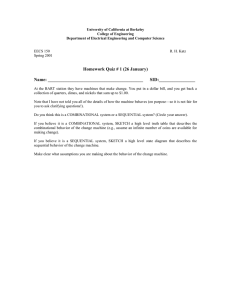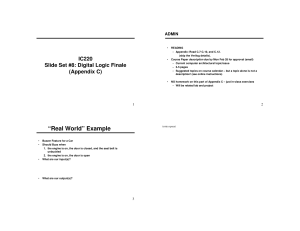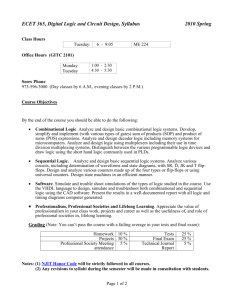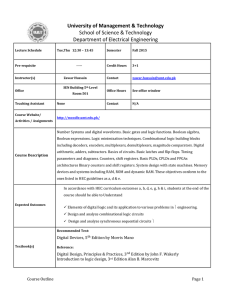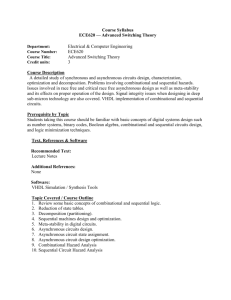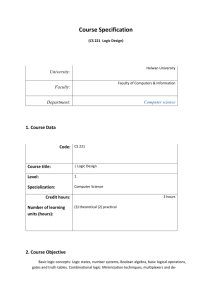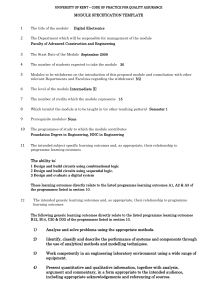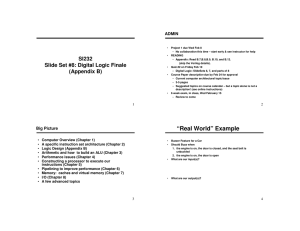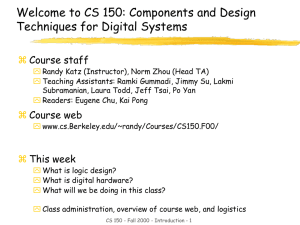IC220 ADMIN
advertisement
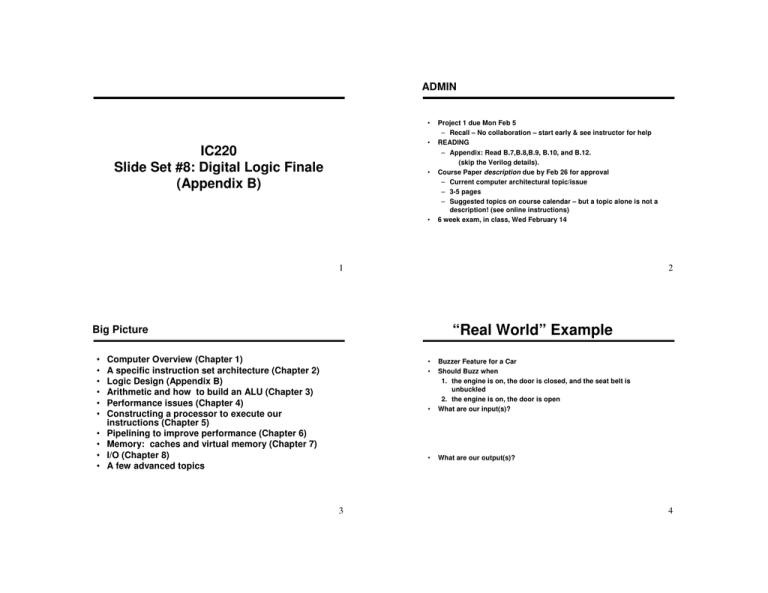
ADMIN • • IC220 Slide Set #8: Digital Logic Finale (Appendix B) • • Project 1 due Mon Feb 5 – Recall – No collaboration – start early & see instructor for help READING – Appendix: Read B.7,B.8,B.9, B.10, and B.12. (skip the Verilog details). Course Paper description due by Feb 26 for approval – Current computer architectural topic/issue – 3-5 pages – Suggested topics on course calendar – but a topic alone is not a description! (see online instructions) 6 week exam, in class, Wed February 14 1 2 “Real World” Example Big Picture • • • • • • • • • • Computer Overview (Chapter 1) A specific instruction set architecture (Chapter 2) Logic Design (Appendix B) Arithmetic and how to build an ALU (Chapter 3) Performance issues (Chapter 4) Constructing a processor to execute our instructions (Chapter 5) Pipelining to improve performance (Chapter 6) Memory: caches and virtual memory (Chapter 7) I/O (Chapter 8) A few advanced topics • • 3 • Buzzer Feature for a Car Should Buzz when 1. the engine is on, the door is closed, and the seat belt is unbuckled 2. the engine is on, the door is open What are our input(s)? • What are our output(s)? 4 (extra space) Check Yourself • • • • Could you have filled in the truth table? Could you have filled in the K-Map? Can you use the K-Map to minimize the equation? Can you draw the circuit? 6 Bigger Units of Combinational Logic • • Multiplexor – Example Usage Gates useful but fairly low level Easier to constructs circuits with higher-level building blocks instead: – Combinational Logic $t0 $t1 $t2 • Multiplexors (mux) • Decoders – (later) Sequential Logic Adder • Registers • Arithmetic unit (ALU) • What is this an example of? $a2 $a3 7 8 Multiplexor – 1-bit version Multiplexor – Wider version EN • 32 bit wide, 2-way Mux: • Pictures don’t always show the width (especially if 32 bits) EX: B-31 to B-32 S1 S0 D3 D2 D1 D0 • • • • Q Think of a mux as a selector S selects one input to be the output N-way mux has – # inputs: – # selector lines (S): – # outputs: Implementation? 9 10 Combinational vs. Sequential Logic End of Combinational Logic 11 • Combinational Logic – output depends only on • Sequential Logic – output depends on: • Previous inputs are stored in “state elements” – __________ determines when an element is updated • State elements will involve use of feedback in circuit – Not permitted in combinational circuits 12 Truth Tables Next State Tables Clocks and State Elements • New kind of input: • • Clock Frequency is the __________ of _______________. When should updates occur to state elements? – Edge – change state when A B Qt Qt+1 0 0 0 0 0 0 1 1 0 1 0 1 0 1 1 1 1 0 0 0 1 0 1 0 1 1 0 0 1 1 1 1 D-Type Flip Flop • State only changes • Otherwise… remembers previous state Abstraction: • – Level – change state when 13 EX: B-41 14 State Diagrams • State = Contents of memory • Diagrams are a tool to represent ALL transitions from one state to another – What causes state changes? • Example for D Flip-Flop: D Q C Q=0 Q-flipflop 15 Q=1 16 Finite State Machines • • • Can use state diagrams to express more complex sequential logic. Example: Candy Machine – Inputs: N (nickel received), D (dime received) – Outputs: C (dispense candy), R (give refund) – Should dispense candy after 15 cents deposited, + refund if overpaid. Then await next customer. We’ll use Moore machine – output depends only on • What states do we need? Example: Candy Machine Inputs: (N)ickel, (D)ime Outputs: (C)andy, (R)efund 17 Implementing Finite State Machines • • • Squares = Circles = We don’t always show the clock for registers/memory diagrams, but will be implicit EX: B-51 to B-53 18 FSM Example 19 20 Registers and Register Files Combining Combinational and Sequential Logic • • Finite State Machine was our first example of this Two general patterns: 1. State Machine • Registers store data (bits) (i.e. have memory) – Each register = • Register files contain: – Set of registers – Logic for read/write • MIPS register file has how many registers? • How does it store data? • How does it know which register to access? 2. Pipeline • In either case, have important timing concerns – Output of combinational logic block may oscillate before settling – Clock cycle time must be long enough so combo-logic settles before the sequential logic (state) reads the new value – State elements ensure that combo-logic inputs remain stable 21 Memory 22 Appendix B Summary • Why so many types? • • Basic types: – RAM “random access memory” (read/write) • • Main memory • Volatile • Types: • – SRAM – async, sync, pipeline burst, cache; – DRAM – M, FPM, EDO, burst EDO, sync, DR, DDR • – ROM (read only) • • • • • Small Stores critical operating instruction (BOOT strap) Non-volatile Common in embedded system (toys, cameras, printers, etc) Types: PROM, EPROM, EEPROM, flash memory • • 23 Truth tables and Gates – AND, OR, NOT, NOR, NAND, XOR Boolean Algebra – Distributive, DeMorgan’s, Inverse, Identity, etc Combinational Logic – Circuits – Design, reduction / minimization, K-maps – Multiplexor Sequential Logic – Flip/flops – Clock & state diagrams Register files Memory – RAM vs ROM, SRAM vs. DRAM 24
